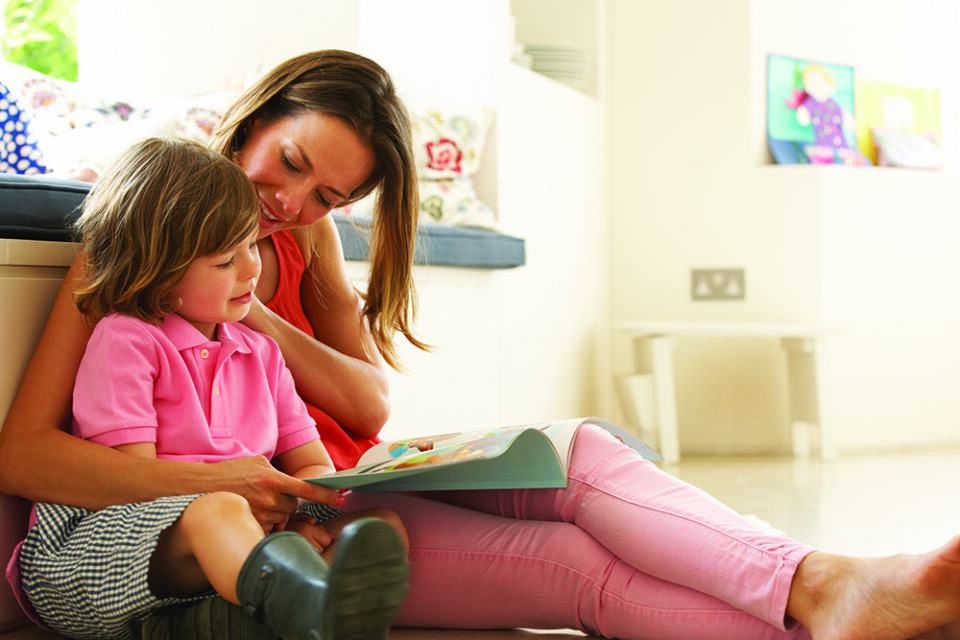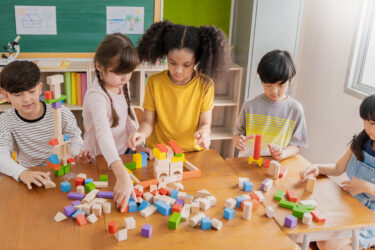You hear talk of how you should read aloud to babies and that reading aloud puts kids on the right track during their early developmental years, that reading aloud helps nurture a love of reading that will last into adulthood … but what makes reading aloud so critical? And why read aloud to older kids if they can read for themselves? Reading aloud to your children — when we’re ALL so challenged by the lure of “cyberland”, offers significant benefits, not the least of which is simply time spent together.
Unplug with Your Baby
Reading aloud nurtures the relationship between you and your baby, but it also lays the foundation for a positive relationship between your child and books, starting him on a life-long association between reading and happy memories. Reading aloud also stimulates language and literacy skills; studies have shown that children who are read to as infants have a larger vocabulary by age 3 than children who aren’t read to regularly. Reading aloud is a multi-sensory experience — your baby is reassured by your touch when you hold him, he is engaged by the sound of your voice, he can take in the pages before him and watch as you point to certain images, and he can experience the feel of a book, practicing and improving his motor skills as he learns how to manipulate a book and turn its pages.
Pulling out a book to read with your little one in our world of tablets, laptops and smart phones might seem a little “old school.” But according to John Hutton, M.D., also owner of blue manatee children’s bookstore, those old-school activities offer a lot of value, and are what inspired his series, Baby Unplugged (babyunplugged.com). The board books are an answer to what Hutton calls “baby media” like the DVDs and “screen-based” products that supposedly make your baby smarter. (The American Academy of Pediatrics asserts that there isn’t enough scientific evidence to prove that “baby brain stimulation” DVDs and CDs actually result in better brain development in babies.) Instead, the Baby Unplugged books are designed to use one “old school” experience — reading aloud — to inspire other “old school” experiences, like playing with a box, blocks or a ball, or getting outdoors and exploring rain and puddles. Those simple activities, says Hutton, “encourage kids to harness their imagination and interact with the real world.”
Next, Keep Reading
So what happens as kids get older? Keep reading! “As long as they’ll tolerate it!” laughs Hutton, admitting that reading aloud to older kids can be more difficult. “There are so few opportunities to sit down, it’s tempting to let kids drift off and read on their own.” And this is where what is known as “dialogic reading” comes into play. Developed by Grover J. Whitehurts, Ph.D., dialogic reading takes an interactive approach to reading aloud — parents will ask questions about the book, and listen as children narrate what they are reading, creating a discussion about the book, all of which reinforces vocabulary and literacy skills.
Reading aloud to older children — even up to age 14, who can comfortably read to themselves — has benefits both academic and emotional, according to Jim Trelease, who could easily be named the King of the Read-Aloud. Trelease, a retired journalist and father, turned his passion for reading aloud to his children into the multi-million dollar selling The Read-Aloud Handbook back in 1979. It remains a bestseller that’s been printed seven times over.
“The first reason to read aloud to older kids is to consider the fact that a child’s reading level doesn’t catch up to his listening level until about the eighth grade,” says Trelease, referring to a study by Dr. Thomas G. Sticht, showing that kids can understand books that are too hard to decode themselves if they are read aloud. “You have to hear it before you can speak it, and you have to speak it before you can read it. Reading at this level happens through the ear.”
Trelease says modeling the pleasure of reading is important, but there are more reasons read-alouds work so well — like “broadening the menu.”
“Let’s take a 9-year-old who’s just finished two solid years of drill and skill, a lot of testing, a lot of work. They’re competent, but they’re thinking in terms of reading as a ‘sweat’ experience,” he says. “When a teacher or parent reads a good book above the student’s reading level, they show that the good stuff — really great books — are coming down the road, if they can stick with it.”
“Broadening the menu” becomes even more important if a child has difficulties with reading, says homeschooling parent Willie Stanton, mom of a child with dyslexia. “Reading together — with her watching the words as I read, and then her reading to me — is a way to be together, to experience the world, to enjoy a common pleasure. I read to her about two-thirds of the time, and then she takes over for one-third of the time. We pass the book back and forth, although we’re usually right next to each other,” she says. And though her daughter struggles, Stanton admits she reads to her child for more than just academic benefits. “This is a time — tweens, teens — when life is full of craziness. This is one way to have a place of rest, of being, something to count on each day. Shared words have power, an energy that you can’t get from the isolated world of technology,” she says.
For Trelease, the power of shared words is a big reason to keep on reading aloud after children are able to read for themselves. Kids might interject questions, comfortably wading into complicated or difficult subjects because they are happening to characters in the story, and not to themselves, plus you can discover the vocabulary that needs learning, making it enjoyable rather than rote.
So whether you’re reading to your baby, exploring a first board book, or a “tween” diving into Harry Potter and the Sorcerer’s Stone, reading out loud together is a way to keep building that love of learning, and an incredibly valuable way to connect with your child in your every day life.
As Hutton says, “Books are a great catalyst to bring grown-ups and children together, especially today.”
Read Aloud Programs
Local libraries often offer changes for kids to practice their read-aloud skills with therapy dogs or other reading buddies, providing a non-judgmental audience. Get a complete schedule of story time and read-aloud opportunities online at:
- Public Library of Cincinnati & Hamilton County — cincinnatilibrary.org
- Kenton County Public Library — kentonlibrary.org
- Boone County Public Library — bcpl.org
- Campbell County Public Library — cc-pl.org
- Clermont County Public Library — clermontlibrary.org
Books to Read Aloud
Children’s librarians from the Public Library of Cincinnati and Hamilton County compiled a suggested reading list of great books to read aloud with your kids!
Babies/Toddlers
- Time for Bed by Mem Fox (Red Wagon Books/Harcourt Brace; 1997)
- I Kissed the Baby! by Mary Murphy (Candlewick; 2004)
Preschool & Kindergarten
- Interrupting Chicken by David Ezra Stein (Candlewick; 2010)
- A Frog in the Bog by Karma Wilson (Margaret K. McElderry Books; 2007)
Grades 1 – 3
- Penny and Her Marble by Kevin Henkes (Greenwillow Books; 2013)
- The Firehouse Light by Janet Nolan (Tricycle Press; 2010)
Grades 4 – 6
- The Sisters Grimm: Fairy Tale Detective by Michael Buckley (Harry N. Abrams; 2007)
- Follow, Follow: a Book of Reverso Poems by Marilyn Singer (Dial; 2013)
Grades 6 – 8
- Bloody Jack: Being an Account of the Curious Adventures of Mary “Jacky” Faber, Ship’s Boy by L.A. Meyer (HMH Books for Young Readers; 2010)
- The Lightning Thief: The Graphic Novel by Rick Riordan (Hyperion Book; 2010)





